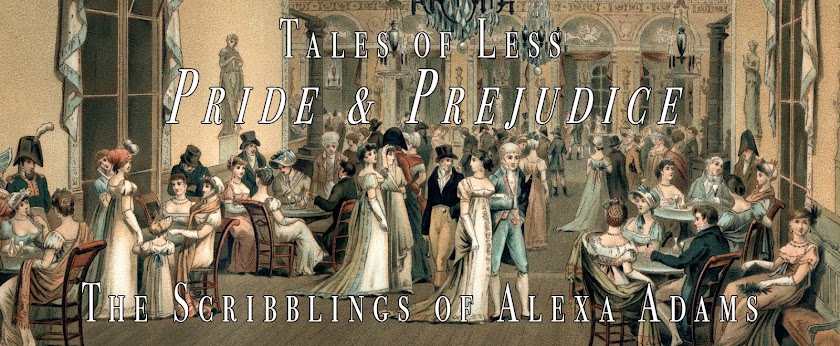 Since I've been in Sense and Sensibility mode, I am going to start with The Third Sister by Julia Barrett, a continuation of that novel focusing, as the name implies, on Margaret Dashwood. This is the third book by Ms. Barrett I have read, experiencing very different reactions to the previous two. The first, Presumption: An Entertainment, was one of the earliest bits of Austen fan fiction I read. Its subject is Georgiana Darcy, and I thoroughly enjoyed the story, Ms. Barrett's use of language, and her ability to capture Austen's tone. Then I read Jane Austen's Charlotte (read my review here), a Sanditon completion, which I found convoluted in plot and almost incomprehensible. This latter experience made me a bit apprehensive of The Third Sister, but though it wasn't as pleasing as Presumption, I found it far superior to Charlotte. Here again Ms. Barrett successfully captures Austen's witty style, providing a pleasing continuation to Sense and Sensibility. I could not help but compare it to another Sense and Sensibility continuation - Willoughby's Return by Jane Odiwe (read my review here) - as both focus on Margaret. For a variety of reasons, I prefer Ms. Odiwe's book, but am nonetheless excited to have discovered another fulfilling Sense and Sensibility continuation.
Since I've been in Sense and Sensibility mode, I am going to start with The Third Sister by Julia Barrett, a continuation of that novel focusing, as the name implies, on Margaret Dashwood. This is the third book by Ms. Barrett I have read, experiencing very different reactions to the previous two. The first, Presumption: An Entertainment, was one of the earliest bits of Austen fan fiction I read. Its subject is Georgiana Darcy, and I thoroughly enjoyed the story, Ms. Barrett's use of language, and her ability to capture Austen's tone. Then I read Jane Austen's Charlotte (read my review here), a Sanditon completion, which I found convoluted in plot and almost incomprehensible. This latter experience made me a bit apprehensive of The Third Sister, but though it wasn't as pleasing as Presumption, I found it far superior to Charlotte. Here again Ms. Barrett successfully captures Austen's witty style, providing a pleasing continuation to Sense and Sensibility. I could not help but compare it to another Sense and Sensibility continuation - Willoughby's Return by Jane Odiwe (read my review here) - as both focus on Margaret. For a variety of reasons, I prefer Ms. Odiwe's book, but am nonetheless excited to have discovered another fulfilling Sense and Sensibility continuation. The Third Sister is structurally similar to Sense and Sensibility. Margaret meets first one gentleman, then a second. She believes herself in love with the first, but, upon discovering him to be a scoundrel (which event allows gentleman number two to demonstrate his superiority), reassesses her affections. There is a removal from Barton Cottage to a place of hustle and bustle (Brighton, in this case) under the aegis of an older widowed woman, just like Elinor and Marianne went to London with Mrs. Jennings. But the Margaret Dashwood Ms. Barrett presents does not particularly resemble the original we know from Austen. In fact, the entire book seems to be written because she took offense at one particular line:
Margaret, the other sister, was a good-humored, well-disposed girl; but as she had already imbibed a good deal of Marianne's romance, without having much of her sense, she did not, at thirteen, bid fair to equal her sisters at a more advanced period of life.Hence Ms. Barrett opens her story with, "Sorry is the portion of a third sister," proceeding to dedicate the majority of the first several pages of the book to admonishing Austen for being so cruel. Now this is very difficult for me: though I understand Ms. Barrett is being tongue-in-cheek on this point, I still shudder at the daring involved in leveling such a critique. Still, these passages admirably demonstrate Ms. Barrett's agile use of Austen's style, and I cannot but imagine the the "Genius" would approve:
To the contrary, by the time she reached her seventeenth year, our Margaret Dashwood stood proof that even Genius might at times be disposed towards too hasty an estimation. Margaret's singularity, when examined, was considerable. Not only was her judgment precise, her understanding was swift. She had read more widely as many, and comprehended more than most: nor was this learning achieved at any sacrifice to her sweetness of nature. Let her word be taken as of little weight, her own comfort regarded as disposable; her mind and temper persisted, one as good as the other, worthy enough, in short, to secure for her just tenure as our heroine.Unfortunately, I never was able to feel much connection to "our Margaret Dashwood", enjoying far more the parts of the book that followed the actions of the Brandons and both of the Ferrars couples. If I had one complaint about Willoughby's Return, it was the almost complete absence of Elinor and Edward. No such issues here! Ms. Barrett flips back and forth between Margaret and her older sisters quite easily. The Third Sister is out of print but can be easily found used on Amazon (in hardback too!). I happily recommend it to all those craving more of the Dashwood sisters. .

Excellent review, Alexa!
ReplyDeleteI haven't read this one yet, although it's on my TBR list, but it sounds like a solid choice for a S&S fix.
Happy Friday!
Hi Lori! Hope your summer is wrapping up nicely. It's a very pleasant story and I would love to hear your thoughts on it when you get around to reading it. Take care!
ReplyDelete